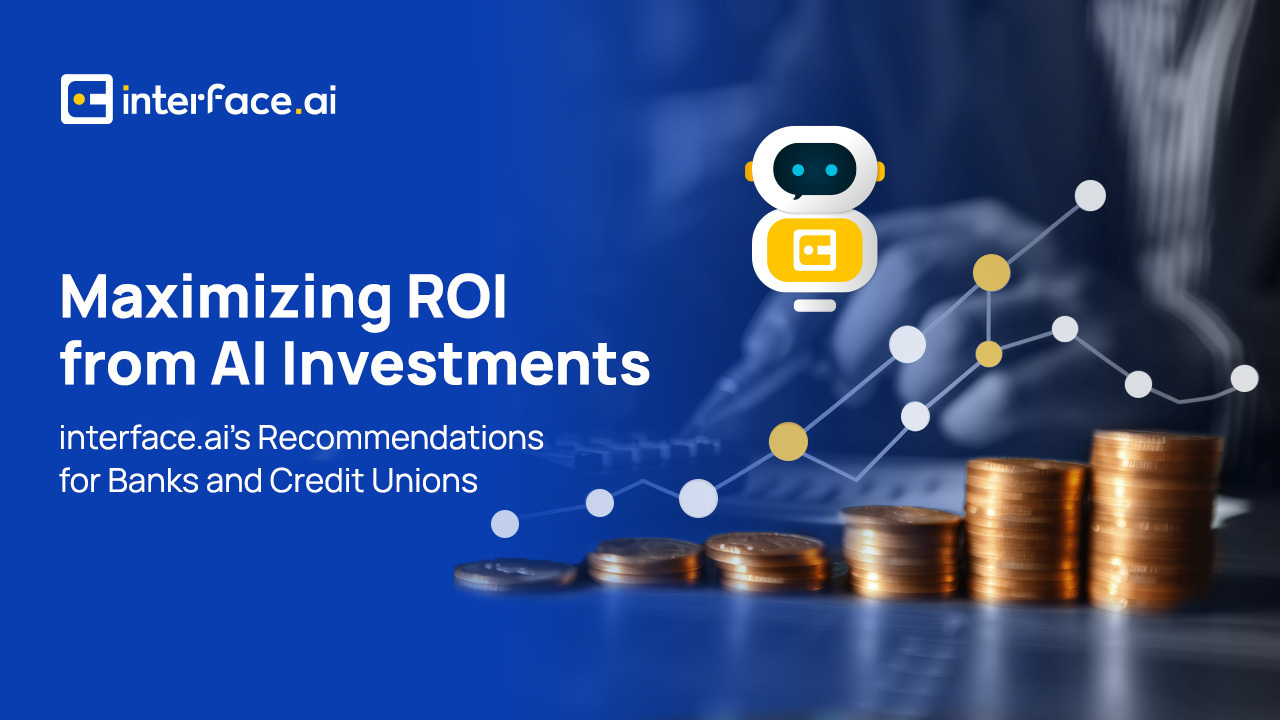
Maximizing ROI from AI Investments: interface.ai’s Recommendations for Banks & Credit Unions
Gartner predicts that 30% of Generative AI (GenAI) projects will be abandoned after proof of concept by the end of 2025. This leaves the financial services industry at a critical juncture. While most banks and credit unions recognize the need to adopt GenAI, many unanswered questions abound, particularly when it comes to ROI with AI.
This blog will take you through the latest insights shared at the Gartner Data & Analytics Summit to explore the various challenges and opportunities that GenAI presents. For banks and credit unions, understanding how to navigate these complexities is key to maximizing ROI with AI and mitigating risk.
The challenges of Generative AI
Gartner’s research underscores several critical challenges in the deployment of GenAI:
1. Poor data quality and inadequate risk controls: GenAI projects often fail due to unreliable data and insufficient risk management frameworks.
2. Escalating costs: The financial burden of developing and deploying GenAI models can be significant, ranging from $5 million to $20 million. While this figure for credit unions and smaller banks will typically be less than this, it still represents a substantial investment.
3. Unclear business value: Justifying the investment in GenAI for productivity enhancements and proving AI ROI is challenging, especially when the financial benefits are not always immediately apparent.
These factors contribute to a high abandonment rate for GenAI projects, as organizations struggle to convert technological advancements into tangible business outcomes.
ROI with AI – Realizing business value
Despite these challenges, successful GenAI implementations have demonstrated substantial benefits and ROI with AI. According to a recent Gartner survey, early adopters have reported:
- 15.8% revenue increase
- 15.2% cost savings
- 22.6% productivity improvement
These metrics highlight the potential for GenAI to drive significant business improvements and AI ROI. However, the value derived from GenAI varies widely based on the specific use case, job type, and skill level of the workforce.
interface.ai’s recommendations for Banks and Credit Unions to achieve ROI with AI
To help banks and credit unions maximize ROI with AI investments and mitigate risks, interface.ai offers the following recommendations:
1. Adopt a multi-channel, integrated AI solution
Avoid the pitfalls of a single AI vendor strategy by choosing vendors that offer multi-channel capabilities and seamless integration with existing systems. View AI as a foundational system rather than an optional component. This approach ensures scalability and flexibility, allowing your AI solution to grow with your institution’s needs.
2. Invest in domain expertise
Partner with AI providers that have deep domain expertise in banking and credit unions. Pre-trained models and pre-built integrations tailored to the financial sector accelerate deployment and enhance the effectiveness of your AI solutions.
3. Leverage performance-based pricing models
Consider vendors that offer performance-based pricing. This model aligns costs with the benefits delivered, ensuring that you only pay more as the AI solution delivers more value. This win-win scenario encourages continuous improvement and accountability from your AI vendor. This is in direct contrast to CCaaS providers – the more interactions automated, the fewer seats that are required and so the lower their revenue.
4. Focus on data quality and risk management
Adopt a solution that offers robust data governance frameworks and risk management protocols. High-quality data is essential for the success of AI projects, and proactive risk controls can prevent costly setbacks.
5. Prioritize clear business value
Define clear, measurable business objectives for your AI initiatives. Focus on use cases that offer immediate and tangible benefits, such as improving customer service, enhancing fraud detection, and optimizing operational efficiency.
6. Scale strategically
Start with pilot projects that address high-impact areas and gradually scale successful implementations across the organization. This approach allows you to refine your AI strategy and ensure that it delivers consistent value.
7. Continuous monitoring and improvement
Establish mechanisms for ongoing monitoring and evaluation of AI performance. Use these insights to continuously optimize and enhance your AI solutions, ensuring they remain aligned with your strategic objectives.
Wrap-up
Navigating the AI landscape and maximizing ROI with AI requires careful planning and strategic investment. By adopting a multi-channel, integrated AI solution, focusing on data quality and risk management, and leveraging performance-based pricing models, banks and credit unions can maximize AI ROI and mitigate risks.
interface.ai’s unified AI platform offers a comprehensive solution that adapts to your evolving needs, ensuring that your institution stays ahead in the rapidly changing financial services landscape. For more insights on maximizing ROI from AI and virtual assistants, contact interface.ai today.
AI Insights for Credit Union & Community Bank Leaders
Join the monthly newsletter for all the latest industry updates

